Nature Post!
I am very happy.
I was determined to go out to the creek this week, because things bloom earlier there than at the lake. I've been watching the skunk cabbage, the May apples, and the trout lilies, my three barometers of earliest spring, and according to them, it was time to find trilliums at the creek.
WHEN to find trilliums is important, because they are spring ephemerals and they are gone almost as soon as they arrive. The hillsides around the creek are the only place I've ever seen so many of them, so their very temporary spring display is one I don't want to miss... and I don't have many chances to go looking any more, with school and work.
I walked. And I saw no trilliums, nothing blooming. A few May apples starting to emerge, a few trout lilies with their flowers closed against the chill.
I started to feel bitter, like the promises of the May apples and the trout lilies had been lies, false hopes. Then I started to feel resigned to the fact that I had turned my back on my lake and the places around it for too long, and that maybe I just couldn't read them anymore, didn't hear their voices anymore. I was wrong, though, it seems. Nature never lies.
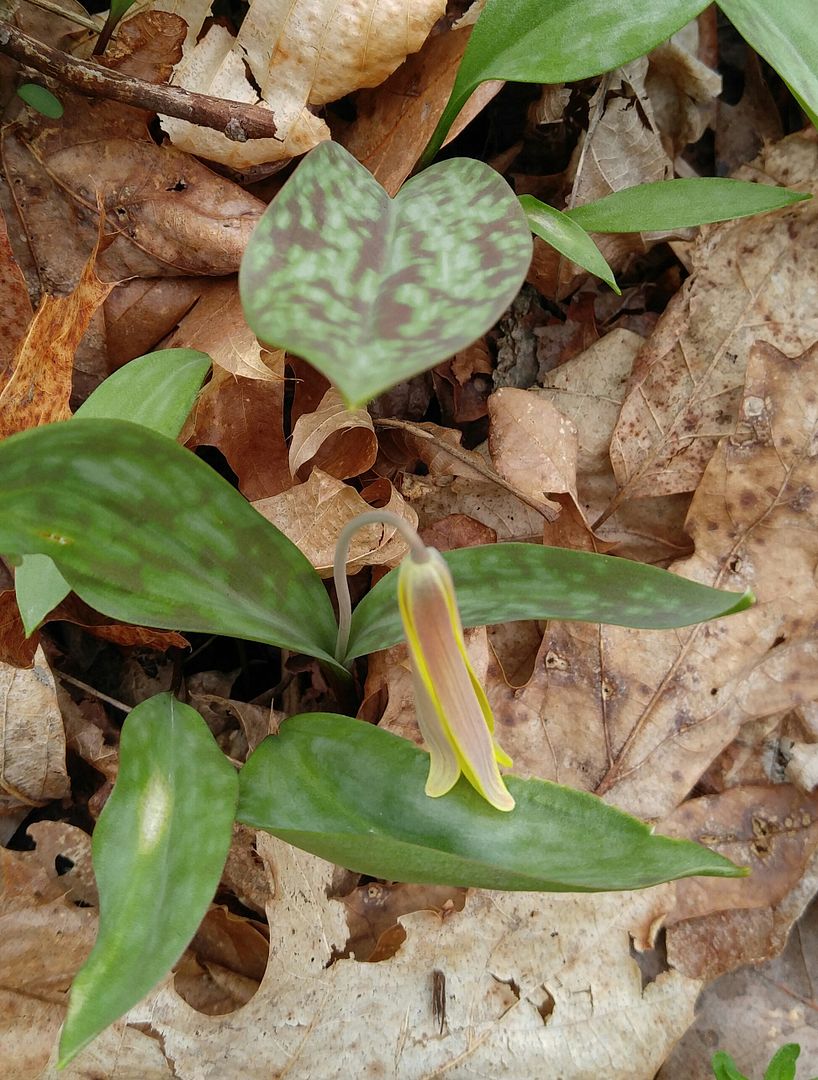
One lonely little trout lily (Erythronium americanum, and a proper lily, which is why I prefer "trout lily" to the other common name, "dog-tooth violet", since they are definitely not a violet) with its flower closed up against the chilly night.
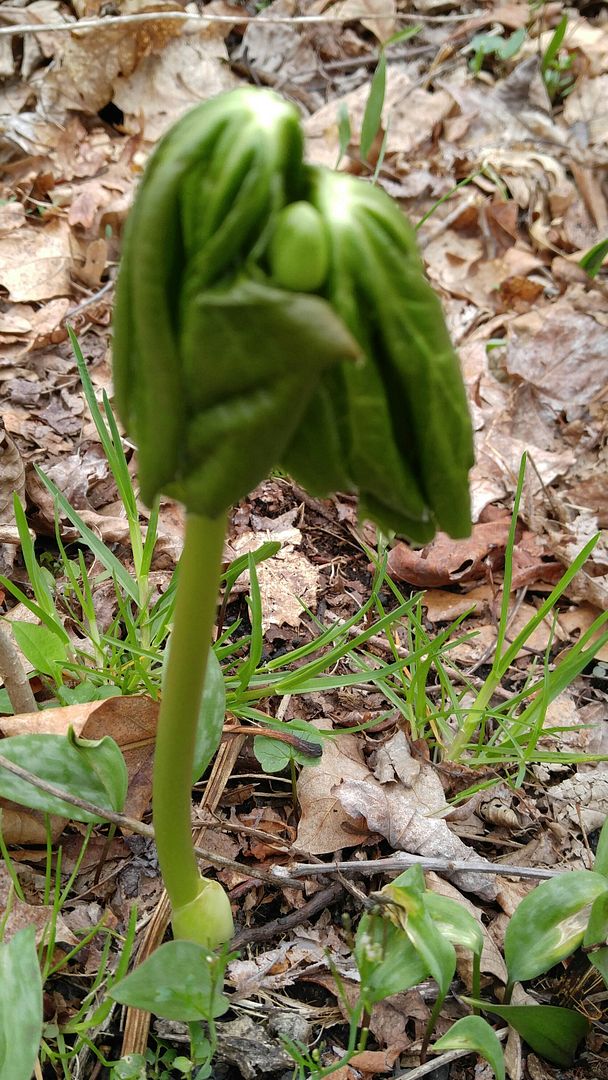
I found May apples (Podophyllum peltatum, the only member of its genus and therefore a biological oddity) beginning to emerge, but perhaps because of the abrupt shifts in weather they looked more like crumpled paper than the little rocket ships I usually see.
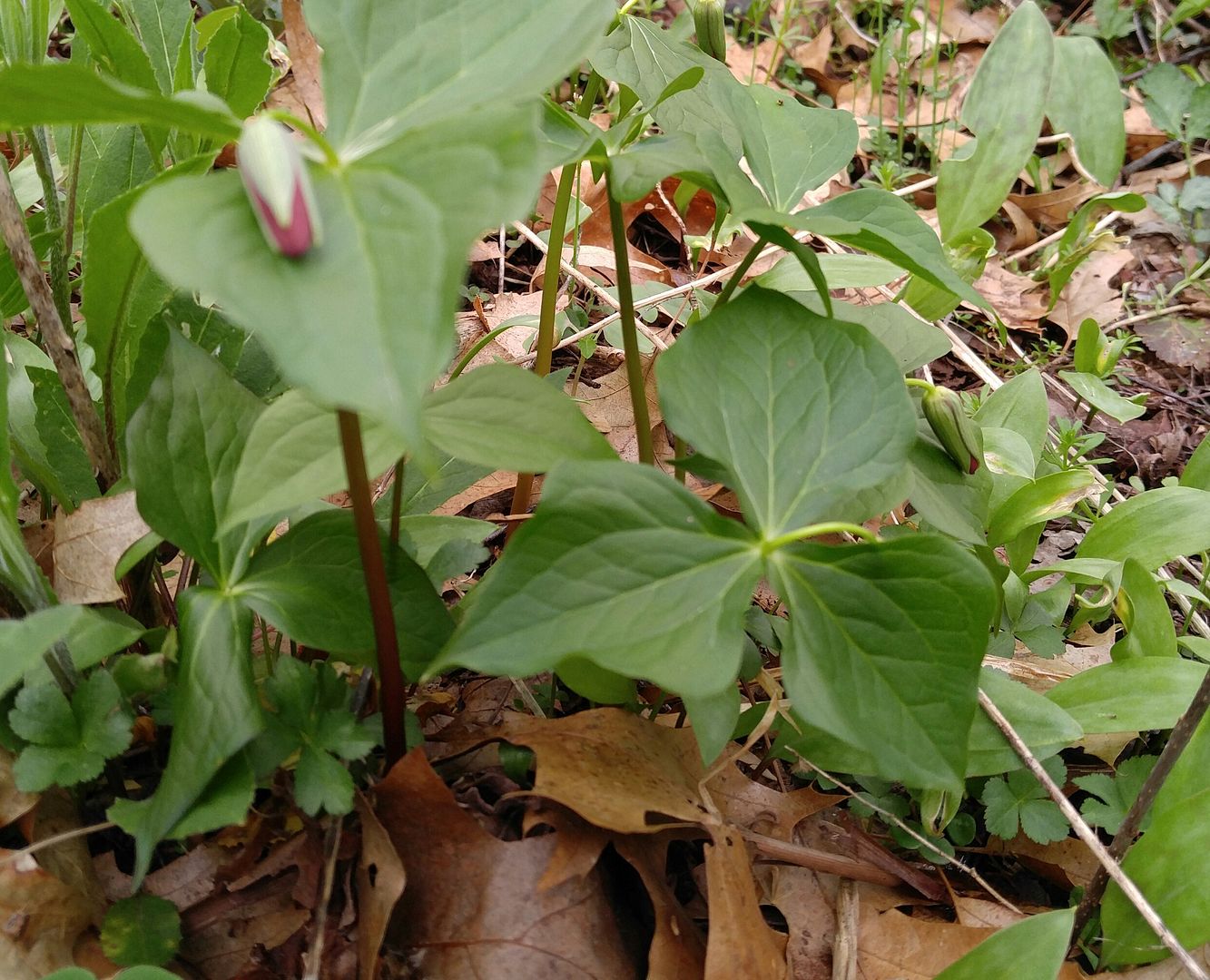
And then I found these... red trilliums (Trillium erectum), still closed up in their buds. I felt relieved that although apparently I'd arrived a little too early for the show, I at least hadn't completely missed the date.
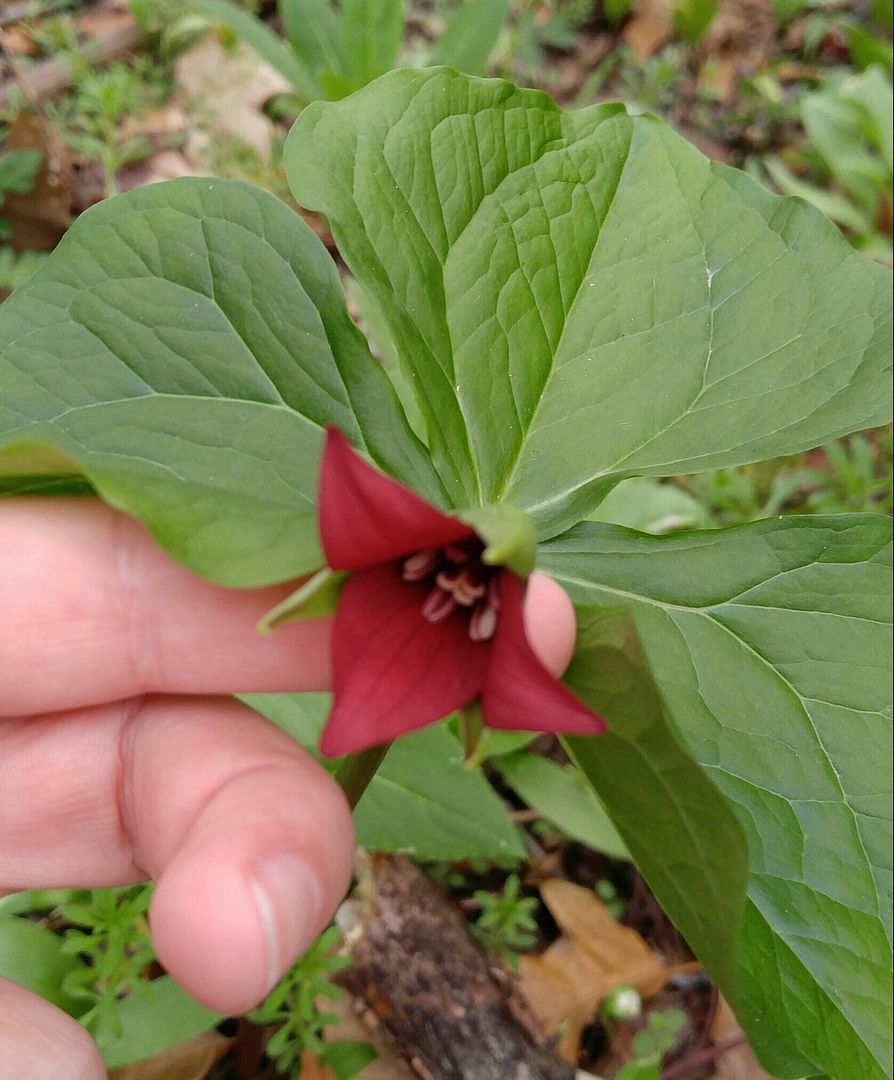
And then I found this one.
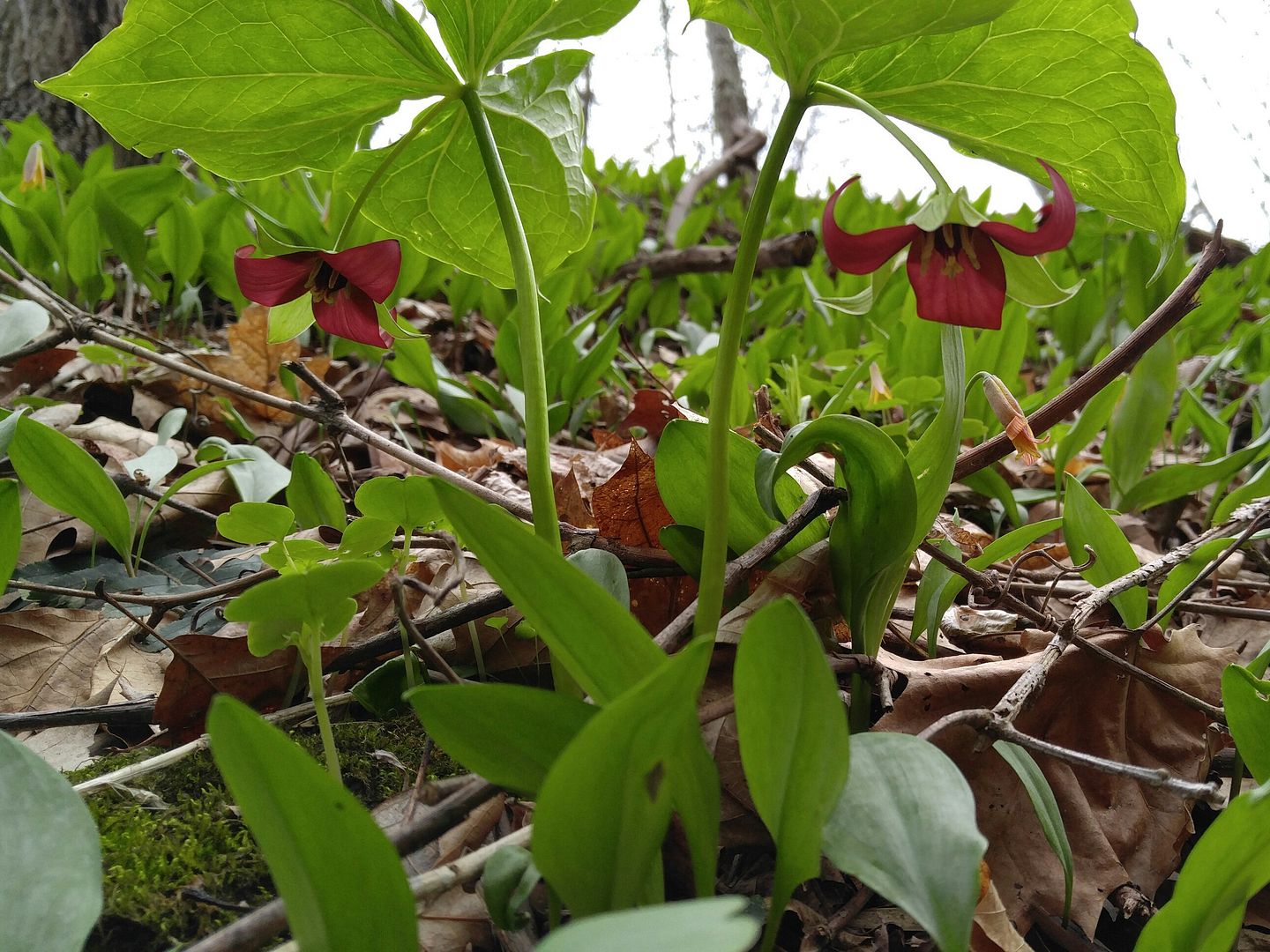
And these.
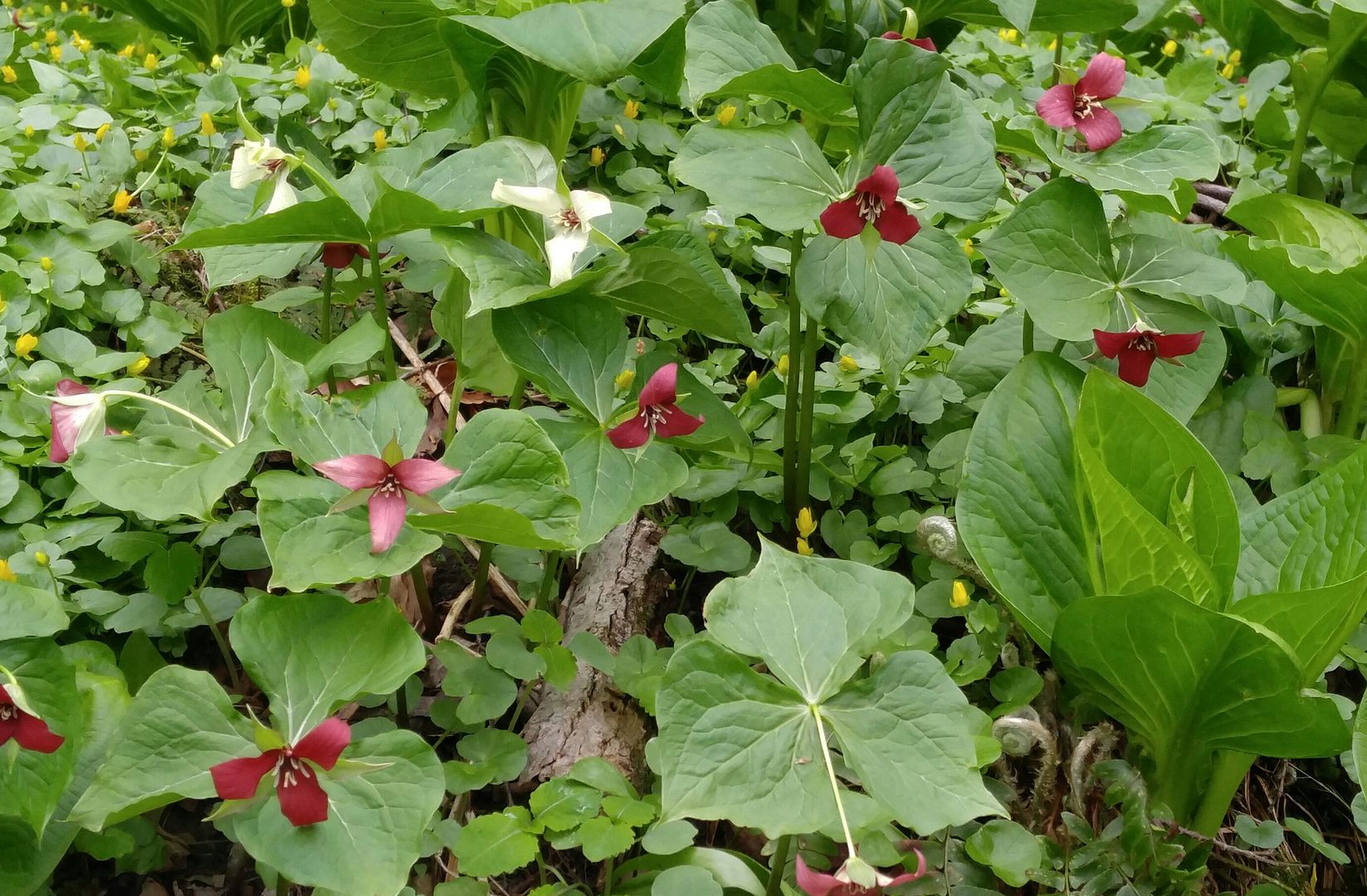
Entire hillsides, blanketed with red trilliums... and even a few of the white color morph thrown in for good measures. Trilliums everywhere, spilling down the hills, filling the dry creek beds, spreading across the low places.
I found myself in tears, not just because I was so happy that I had found my pretty trilliums, but because I HADN'T misread the whispers of spring that told me when to look for them. I hadn't forgotten. It wasn't gone, my memory, my feel for my lake and my woods, my understanding of its cycles and its moods. I hadn't lost it and it hadn't betrayed me, and I stood in the middle of the proof of it, these ephemeral flowers in the prime of their short-lived blooming, knowing I could still listen and still hear. My lake had not turned its back on me, had not shut me out after abandoning it. We still understand each other.
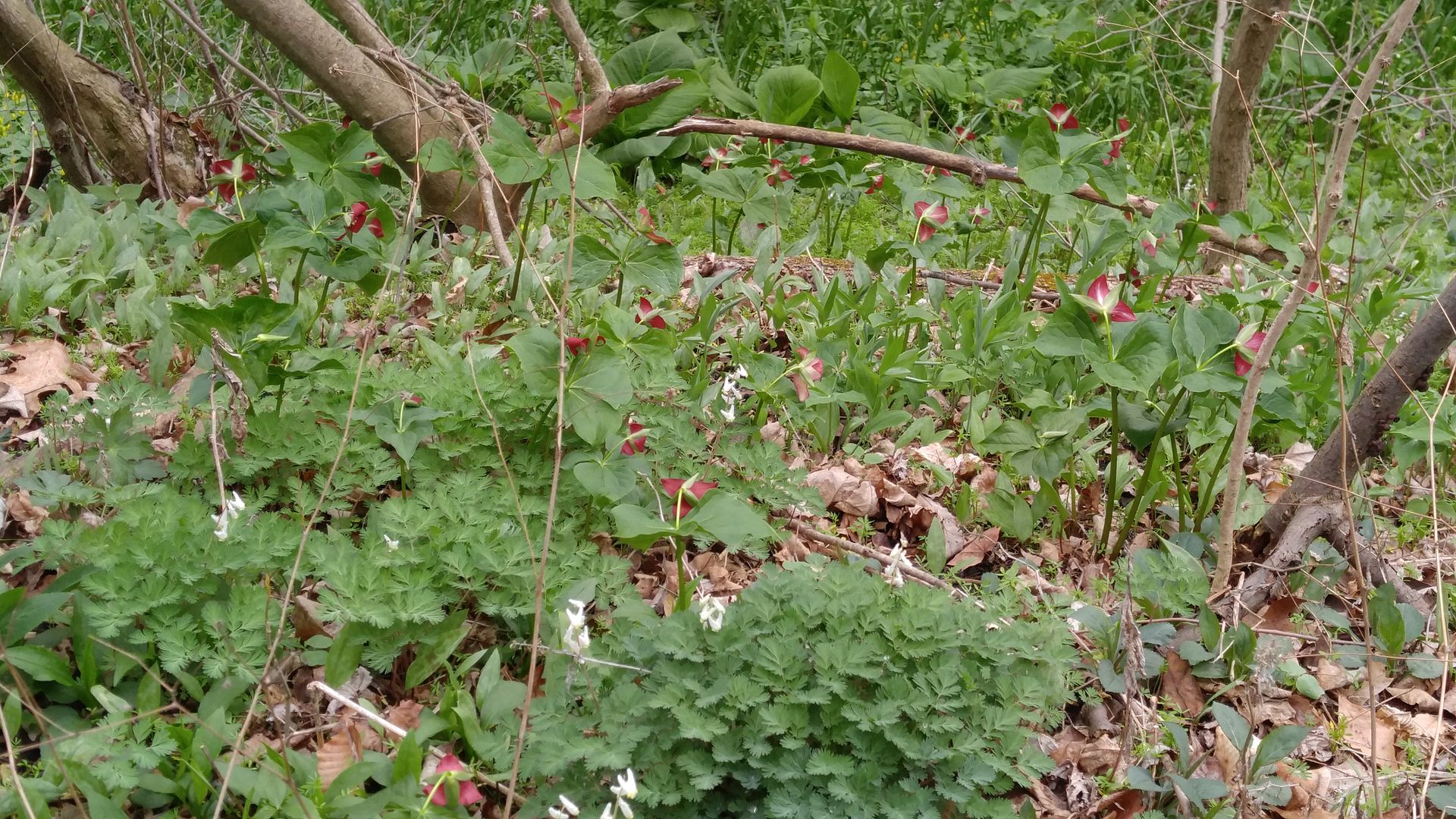
As I was crouched down beside the trail, staring at the deep red flowers and lost in thought, a middle-aged man in a very serious-looking jogging suit with ear buds in his ears went jogging by me in a very serious fashion, doing his exercising. I saw him slow down, glancing over to see what I was looking at, I supposed.
I walked on, and took some more pictures, and I was up to my knees in trilliums off the side of the trail when I looked up and saw him again; apparently he'd reached his turnaround point and was coming back, except that now he was walking, and his ear buds were hanging around his neck. He looked at me.
"Those really deep red flowers," he said. "They're everywhere."
"They're trilliums," I said. "I came out today looking for them. They only last a week or so."
He stood and looked at them. "I jog here every day and I never noticed them. They're gorgeous."
He will notice them now. He will notice them forever. And maybe other things, too. Maybe, in that brief moment of being in the same place at the same time, I changed the way he sees the world he jogs through. Once your eyes are opened, it's never quite the same. Maybe I gave a stranger that moment today.
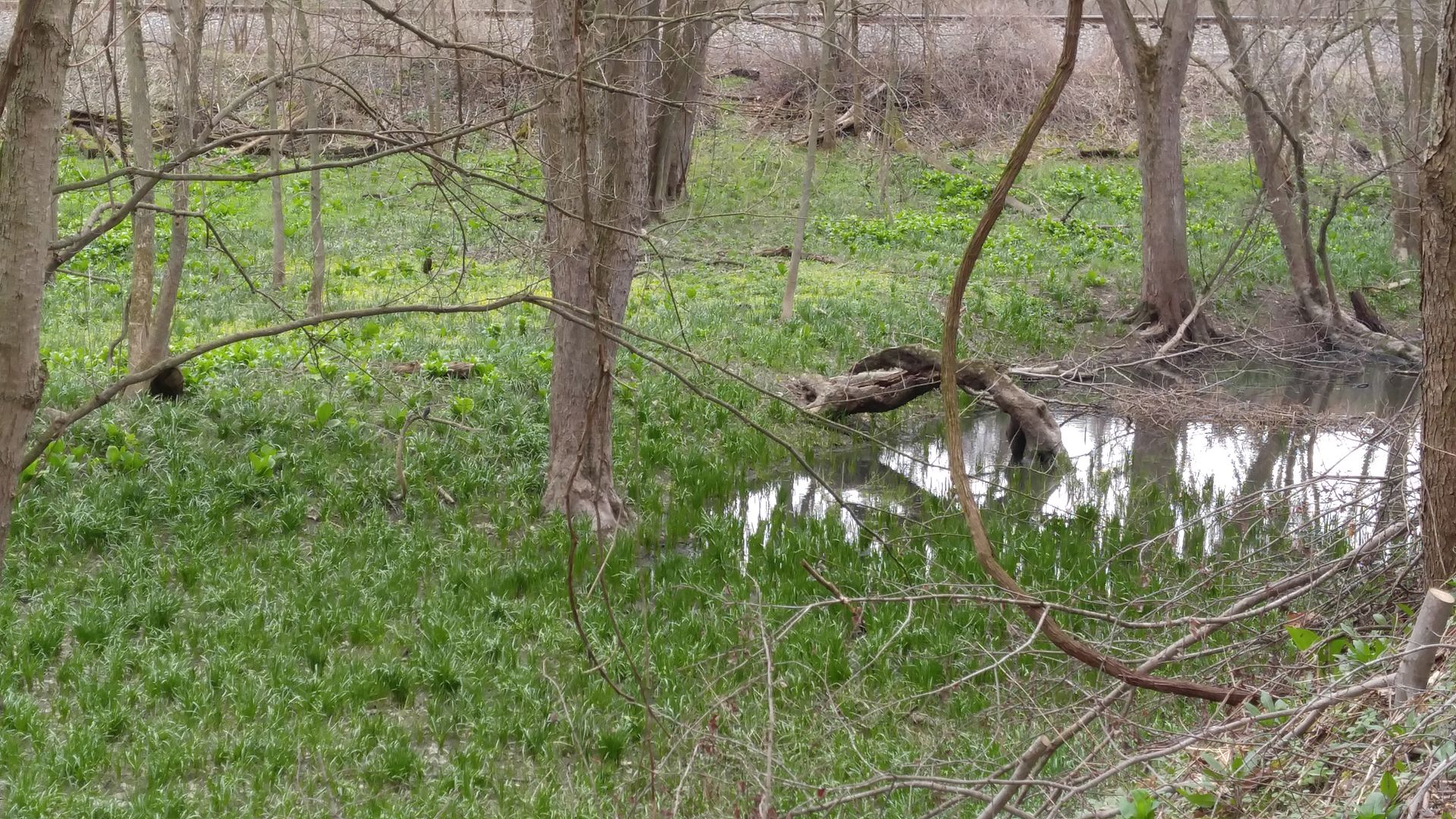
The flood plain around the creek is filling with green things that can tolerate the spring overflow and being half-buried in mud.
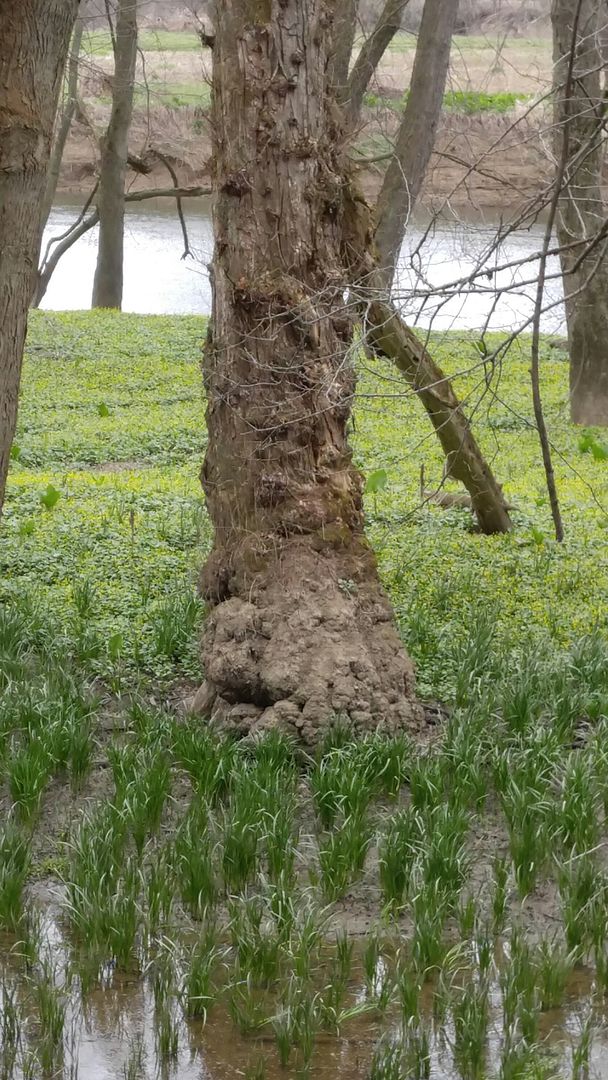
This tree bears the marks of perhaps a hundred years of spring floods, its trunk mud-encrusted and scarred from the impacts of floating debris, its roots buried too deep in the muck for even the strongest water to tear them loose.
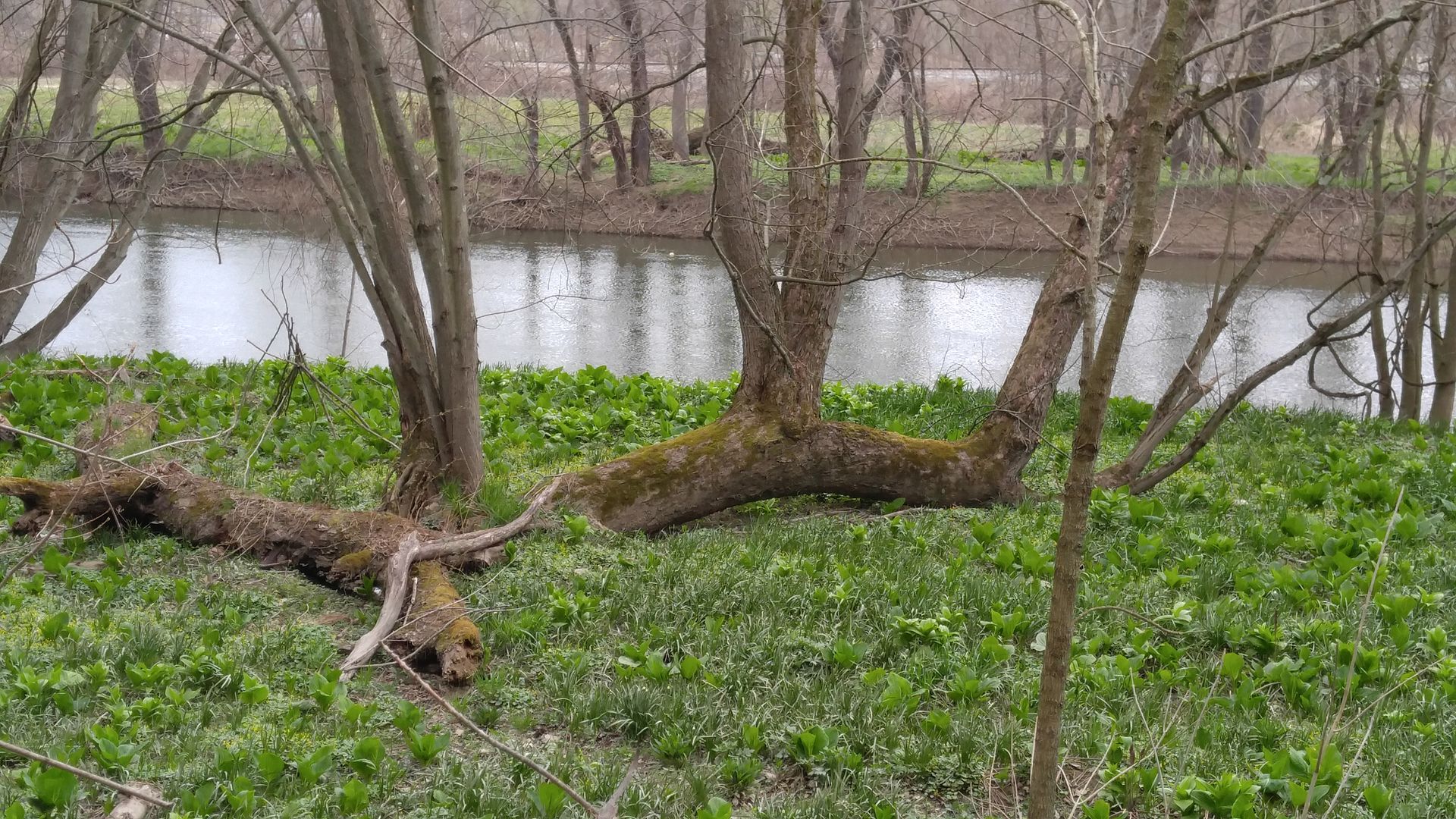
The dinosaur tree lays in its bed of skunk cabbage and ferns, waiting for the water to spill over the banks. It must still have deep roots as well, to last year after year in the overwhelming rush of spring water.
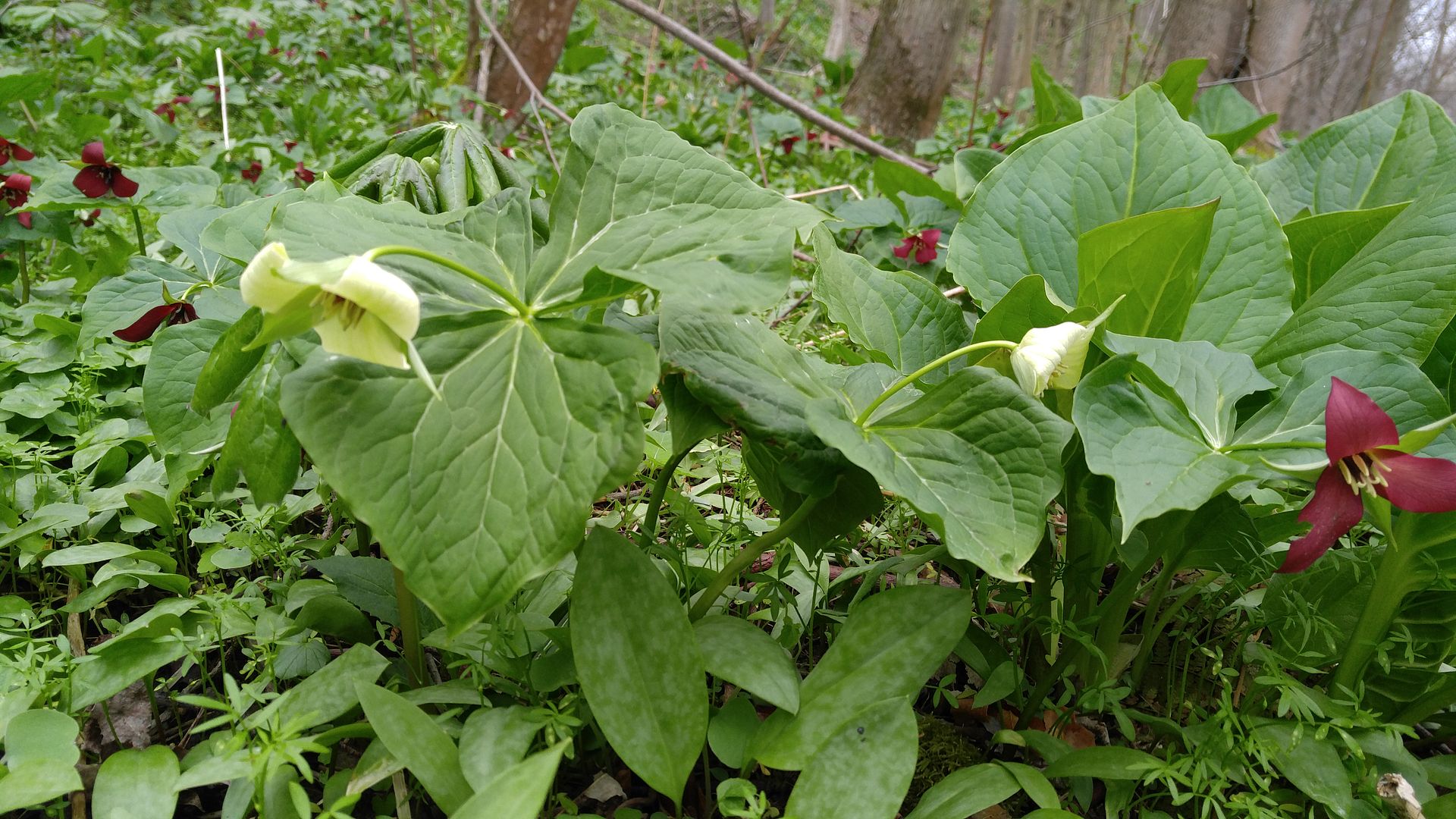
These pretty white color morphs of the red trilliums are unusual here, but in some places they are the dominant ones. I haven't been able to find out much about the genetics and whether the white is a recessive gene or a mutation, but I'll keep looking. There is also an entirely different species of trillium with a white flower.
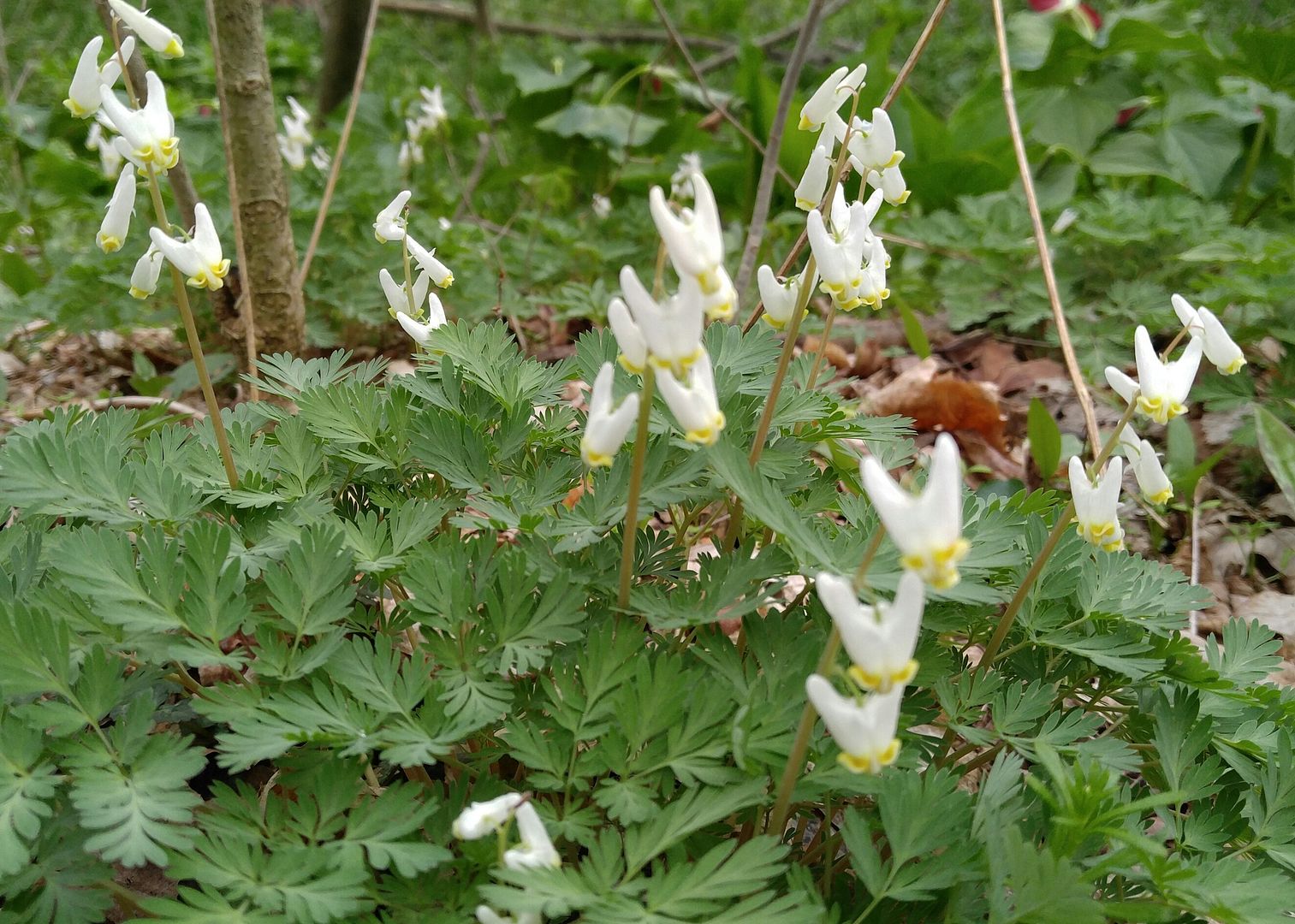
I was filled with delight to find these beautiful little oddities. I don't know if you have them anywhere else in the world, but they are native to eastern North America and they are called Dutchman's Breeches (Dicentra cucullaria). They are a marvelous little flower, and longer-lasting than the trilliums: they are waiting for the bumblebees to wake up, as they are one of several flowers whose shape is such that only bumblebees are stocky and heavy enough to shove their way inside.
So my lake has not forgotten me, and spring has not forgotten me, and the world is beautiful and it is as it should be.
.
.
.
I was determined to go out to the creek this week, because things bloom earlier there than at the lake. I've been watching the skunk cabbage, the May apples, and the trout lilies, my three barometers of earliest spring, and according to them, it was time to find trilliums at the creek.
WHEN to find trilliums is important, because they are spring ephemerals and they are gone almost as soon as they arrive. The hillsides around the creek are the only place I've ever seen so many of them, so their very temporary spring display is one I don't want to miss... and I don't have many chances to go looking any more, with school and work.
I walked. And I saw no trilliums, nothing blooming. A few May apples starting to emerge, a few trout lilies with their flowers closed against the chill.
I started to feel bitter, like the promises of the May apples and the trout lilies had been lies, false hopes. Then I started to feel resigned to the fact that I had turned my back on my lake and the places around it for too long, and that maybe I just couldn't read them anymore, didn't hear their voices anymore. I was wrong, though, it seems. Nature never lies.

One lonely little trout lily (Erythronium americanum, and a proper lily, which is why I prefer "trout lily" to the other common name, "dog-tooth violet", since they are definitely not a violet) with its flower closed up against the chilly night.

I found May apples (Podophyllum peltatum, the only member of its genus and therefore a biological oddity) beginning to emerge, but perhaps because of the abrupt shifts in weather they looked more like crumpled paper than the little rocket ships I usually see.

And then I found these... red trilliums (Trillium erectum), still closed up in their buds. I felt relieved that although apparently I'd arrived a little too early for the show, I at least hadn't completely missed the date.

And then I found this one.

And these.

Entire hillsides, blanketed with red trilliums... and even a few of the white color morph thrown in for good measures. Trilliums everywhere, spilling down the hills, filling the dry creek beds, spreading across the low places.
I found myself in tears, not just because I was so happy that I had found my pretty trilliums, but because I HADN'T misread the whispers of spring that told me when to look for them. I hadn't forgotten. It wasn't gone, my memory, my feel for my lake and my woods, my understanding of its cycles and its moods. I hadn't lost it and it hadn't betrayed me, and I stood in the middle of the proof of it, these ephemeral flowers in the prime of their short-lived blooming, knowing I could still listen and still hear. My lake had not turned its back on me, had not shut me out after abandoning it. We still understand each other.

As I was crouched down beside the trail, staring at the deep red flowers and lost in thought, a middle-aged man in a very serious-looking jogging suit with ear buds in his ears went jogging by me in a very serious fashion, doing his exercising. I saw him slow down, glancing over to see what I was looking at, I supposed.
I walked on, and took some more pictures, and I was up to my knees in trilliums off the side of the trail when I looked up and saw him again; apparently he'd reached his turnaround point and was coming back, except that now he was walking, and his ear buds were hanging around his neck. He looked at me.
"Those really deep red flowers," he said. "They're everywhere."
"They're trilliums," I said. "I came out today looking for them. They only last a week or so."
He stood and looked at them. "I jog here every day and I never noticed them. They're gorgeous."
He will notice them now. He will notice them forever. And maybe other things, too. Maybe, in that brief moment of being in the same place at the same time, I changed the way he sees the world he jogs through. Once your eyes are opened, it's never quite the same. Maybe I gave a stranger that moment today.

The flood plain around the creek is filling with green things that can tolerate the spring overflow and being half-buried in mud.

This tree bears the marks of perhaps a hundred years of spring floods, its trunk mud-encrusted and scarred from the impacts of floating debris, its roots buried too deep in the muck for even the strongest water to tear them loose.

The dinosaur tree lays in its bed of skunk cabbage and ferns, waiting for the water to spill over the banks. It must still have deep roots as well, to last year after year in the overwhelming rush of spring water.

These pretty white color morphs of the red trilliums are unusual here, but in some places they are the dominant ones. I haven't been able to find out much about the genetics and whether the white is a recessive gene or a mutation, but I'll keep looking. There is also an entirely different species of trillium with a white flower.

I was filled with delight to find these beautiful little oddities. I don't know if you have them anywhere else in the world, but they are native to eastern North America and they are called Dutchman's Breeches (Dicentra cucullaria). They are a marvelous little flower, and longer-lasting than the trilliums: they are waiting for the bumblebees to wake up, as they are one of several flowers whose shape is such that only bumblebees are stocky and heavy enough to shove their way inside.
So my lake has not forgotten me, and spring has not forgotten me, and the world is beautiful and it is as it should be.
.
.
.